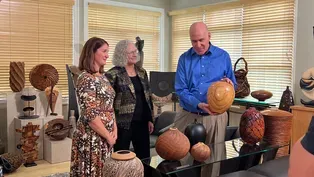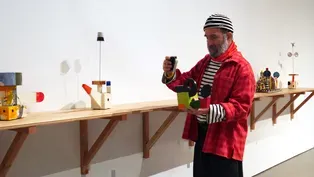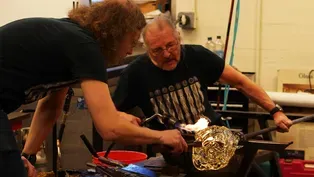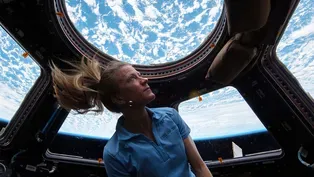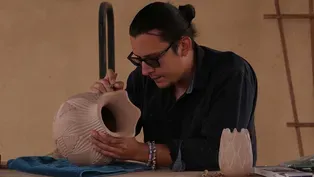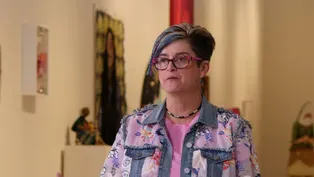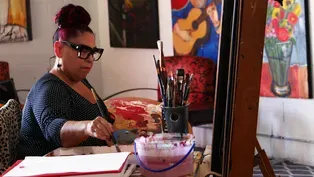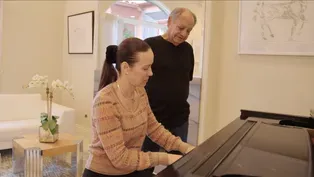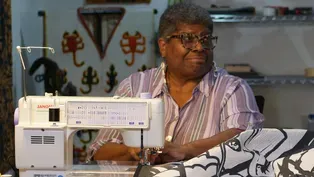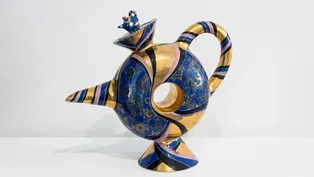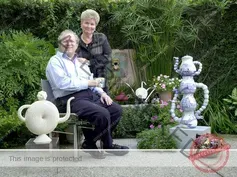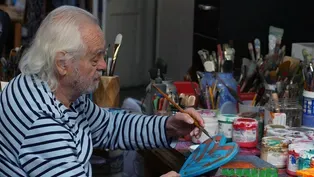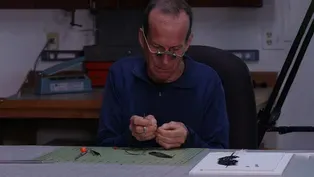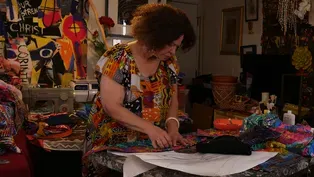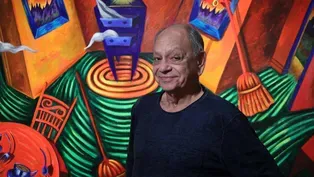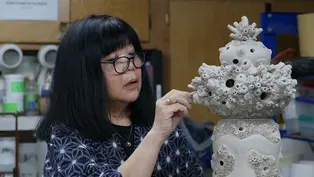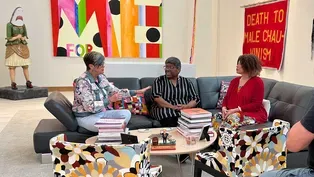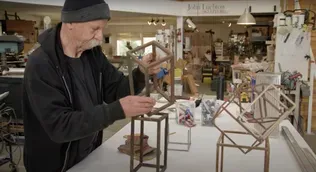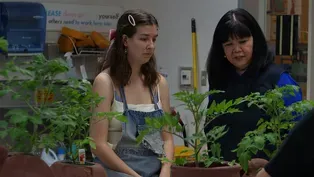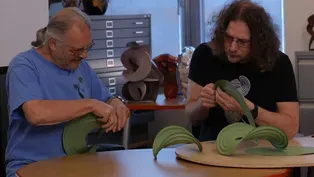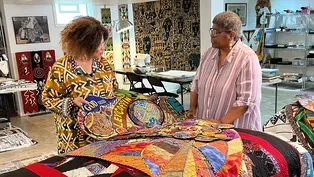
Fleur Bresler, Judith Chernoff, Jeffrey Bernstein, Norm Sartorius segment
Clip: Season 16 | 13m 14sVideo has Closed Captions
Meet three collectors Fleur Bresler, Judith Chernoff & Jeffrey Bernstein and sculptor Norm Sartorius
Meet three collectors who have donated work to the Renwick Gallery, Fleur Bresler, Judith Chernoff and Jeffrey Bernstein. They explain why sharing their collections with the public is an essential part of their connection with artists and introduce us to Norm Sartorius, a sculptor who makes fascinating and original spoons. Segment from COLLECTORS episode
Problems with Closed Captions? Closed Captioning Feedback
Problems with Closed Captions? Closed Captioning Feedback

Fleur Bresler, Judith Chernoff, Jeffrey Bernstein, Norm Sartorius segment
Clip: Season 16 | 13m 14sVideo has Closed Captions
Meet three collectors who have donated work to the Renwick Gallery, Fleur Bresler, Judith Chernoff and Jeffrey Bernstein. They explain why sharing their collections with the public is an essential part of their connection with artists and introduce us to Norm Sartorius, a sculptor who makes fascinating and original spoons. Segment from COLLECTORS episode
Problems with Closed Captions? Closed Captioning Feedback
How to Watch Craft in America
Craft in America is available to stream on pbs.org and the free PBS App, available on iPhone, Apple TV, Android TV, Android smartphones, Amazon Fire TV, Amazon Fire Tablet, Roku, Samsung Smart TV, and Vizio.
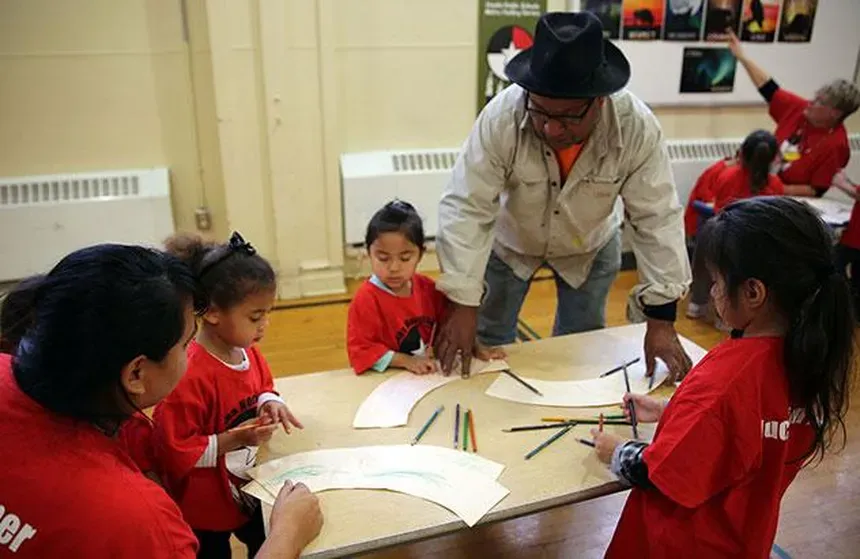
Education Guides
Download Craft in America education guides that educate, involve, and inform students about how craft plays a role in their lives, with connections to American history and culture, philosophies and science, social causes and social action.Providing Support for PBS.org
Learn Moreabout PBS online sponsorshipThe Renwick Gallery is the Smithsonian American Art Museum's branch dedicated to contemporary craft.
When people walk through our doors they get a totally different kind of experience than they're used to.
We're not a gallery full of paintings, we're objects, and people respond to objects.
We try and keep a pulse of what's going on through the arts fairs, through the galleries, and some of the people that we learn from are the collectors that we work with.
Fleur Bresler is one of the, the quiet supporters who's had just such a broad influence.
She's given many, many objects to the Renwick and other museums.
Collecting for me is like a high.
I was born in 1926.
Washington was really a small southern town when I was growing up.
My family had a jewelry store, and on the top floor was the engraver.
And that was where I would be deposited to be quiet and stay out of the way.
And I'd watch him hand engrave.
So, I know what it takes to make something perfect.
The most interesting collectors are the collectors that got in before an artist was very famous.
They had a good eye.
They started collecting early.
They found affordable objects.
Well, my husband was involved politically and I was looking for something that was indigenous to Maryland.
So, duck decoys was where I started collecting.
She quickly expanded the scope of her collecting to turned wood objects.
I was in the vicinity of the Renwick, came in out of the rain.
The guard said, there's a wood show upstairs.
I had never seen wood in that many different colors, all those patterns in it.
And if I could have taken the tops off of the cases I would have.
Fleur has a very particular way of looking and she likes things that are sometimes more avant-garde.
It's got to show imagination, it's got to show skill, and it's got to show that it all comes together to make a object that is attractive.
I like whimsy, and I seem to like animals.
I will buy some wild, quirky sort of things.
Why?
I don't really know.
I'm a gastroenterologist.
And I'm an internal medicine doctor.
We were both in medical school, and, and so I called her up.
That first date turned into four more dates that week, and then we got married and took off on our adventure.
We had a house geared toward the kids.
All the rooms were playrooms.
Then we purchased this kinetic sculpture by David Roy.
At that time, the word collector was totally foreign to us.
But we started going to the craft shows.
Oh, here's a good wood booth.
Going to the shows was learning about what there is in the craft world.
And this is all manzanita.
And the leaves can be moved around.
Looks like flame... We were getting to know the artists.
We learn about their latest series.
Geometric shapes... Is that paint or rope?
About their techniques.
This is wool that dyed.
We would buy a little bit and get more comfortable and then buy a little bit more.
Oh my gosh, beautiful.
Over about six years, we found we were leaning towards the wood artists.
The wood artists were very open about their work and explaining it.
The first stage of our collecting was for simple bowls that brought out the beauty of the wood, the grain and the figure.
Eventually, we started to understand the abstract nature of what some artists were trying to do.
We'd like to tell you a little bit about Stoney Lamar, who we've collected in depth.
This is an early piece of Stoney's, and it does not look like a round bowl, that's because it uses a technique called multi-axis turning.
You still have the vessel in the center, but the bulk of it is holding up the vessel with the flanges here.
The way that Peter Voulkos shocked people in ceramics, I think this was a shocking piece.
So, the next series that he did started introducing metal.
Metal adds a tension.
Wood is warm.
Metal is cold.
This piece was done later on in his career, and this is called, A Well Lit Dark Path.
It's a homage to Stoney's experience going through Parkinson's.
We liked the piece to begin with, but once you know the story behind it, it adds so much more feeling and importance to owning a piece like that.
An artist's life is not easy.
And if I find artists that have imagination I can start giving them that little push forward.
Fleur Bresler has over 70 of my peculiarly shaped wooden spoons.
And she has been the single most active and supportive collector that I've had in, in my career.
The first piece of Norm's that I bought was a spoon-like spoon with a long handle.
But Norm went through a long progression.
I switched from making a variety of things: canes, knife racks, cutting boards, letter openers, shoe horns, to almost exclusively spoons as sculptural art objects.
But I felt some doubt about what I was doing.
I went to Boston three times for a show, I think I only sold a couple of spoons up there.
People would say, this is beautiful, but this is too nice to use.
This is a piece of maple from, that was extra left over from the making of Fleur Bresler's huge, beautiful bed.
I knew the woodworker doing it and he saved some of the wood for me.
I begin by cutting out what doesn't belong.
I'm looking for what the wood has to offer, thinking what can this be?
I think the best work comes when I'm receptive to, call it whatever you want, intuition or the voice in your head.
It's your head, but is it, what's that voice?
The inspiration comes from his heart.
I am the spoon maker's wife.
For 41 years I have received a heart for Valentine's Day.
Wow.
I always encouraged him to take it to extremes.
Make a spoon as, as, as far out as you can make it.
The less conservative it is, the more successful it is.
This is a pneumatic drum sander.
Using a sanding drum as a sculpting tool to refine the shape came from my very first teachers, Phil and Sandy Jurus, before I knew anything.
I was a social worker who gave that up to do a woodworking apprenticeship with them.
There are parts of a spoon, you know.
There's a bowl and a handle, and there's finials.
These little things on the ends of handles keeps both your eye and your hand in the piece.
For me to go toward unique and different forms, I wanted to see what I think of sculptural spoons in other cultures.
At the Smithsonian, they store over 3000 wooden spoons, ladles, or dippers.
They're mostly gathered by anthropologists in the field.
I would open the case, and here's 100 beautiful Filipino spoons or spoons from the northwest coast of the US, where some of the most wonderful spoons are carved.
That just added into the mix.
Once I get it to the depth I want, and have enough wood cut out then that leaves marks in the surface that need to be mostly scraped out with scrapers that I make out of old putty knives.
I'm working first to please myself.
It's about an emotional response to the piece.
That's part of how you know when you're done, does it do that feeling?
And if it does, then I think probably somebody else will like it.
One of the series Norm did was this series called A Spoon of Forgotten Ceremony.
And this was a commissioned piece that we did from him.
It gives the implication that it's a, it's a spoon that was passed from person to person, so therefore there were two handles, and that there was some kind of ceremony that was important, but it was forgotten.
We don't know what the ceremony was, but still, you have the object.
Our collection got so big that we wanted to deaccession a little bit and we wanted more people to see it.
You can feel how light it is because it's very hollow.
It's so light.
And...
I was able to work with them to select 43 works of art in wood for the Renwick Gallery.
Before they left, we took all 43 pieces and put them on tables in the dining room and the living room.
Of course we miss them.
We miss holding them.
One wonderful thing about collectors of the craft world is their commitment.
They are able to let go of it and then let it live with the nation.
Jeff and Judy's works were included in our exhibition, This Present Moment, Crafting a Better World, that celebrated the Renwick's 50th anniversary.
When we walk into the room at the Renwick and see our pieces a smile comes to my face because they're old friends.
But we see the inspiration of people, we see the inspiration of nature, and it all interacts very well.
Wood objects in Fleur, Judy and Jeff's collections
Video has Closed Captions
See more objects in Fleur Bresler's and Judith Chernoff and Jeffrey Bernstein's collections (4m 14s)
Video has Closed Captions
Learn more about Peter Shire's art and career. Bonus video from COLLECTORS episode (6m 29s)
See more of Erik and Martin Demaine's sculptures
Video has Closed Captions
Father-son team make unique curved-crease origami sculptures and incorporate it with glass (4m 47s)
Video has Closed Captions
Joseph & Sergio Youngblood Lugo on bear paw symbols in Santa Clara Pueblo pottery (2m 3s)
Quilt artist Karen Nyberg segment
Video has Closed Captions
Former NASA astronaut and quilter Karen Nyberg continues to create art inspired by space and science (6m 35s)
Potters Joseph & Sergio Youngblood Lugo segment
Video has Closed Captions
Santa Clara Pueblo potters Joseph & Sergio Youngblood Lugo use ancestral techniques in their work (9m 5s)
Objects in Sara Vance Waddell's collection
Video has Closed Captions
Sara Vance Waddell on how she became a collector and shows us pieces in her collection. (5m 15s)
Meet the artists in Cheech Marin's Chicano Art collection
Video has Closed Captions
Learn more about Jaime "Germs" Zacarias, Yolanda González, and Francisco Palomares (8m 42s)
Video has Closed Captions
Pianist Natasha Marin on living with Chicano Art (1m 8s)
Learn more about the Women of Color Quilters Network
Video has Closed Captions
Learn more about Carolyn Mazloomi and the Women of Color Quilters Network (6m 38s)
Joan Takayama-Ogawa's ceramic history
Video has Closed Captions
Artist Joan Takayama-Ogawa on her mentor, Ralph Bacerra and Joan's family history in ceramics (5m 4s)
Gloria & Sonny Kamm and Peter Shire segment
Video has Closed Captions
Meet teapot collectors Sonny and Gloria Kamm and artist Peter Shire in Los Angeles. (9m 32s)
Video has Closed Captions
Chicano artist Frank Romero on his career. Bonus video from COLLECTORS episode (7m 4s)
Fleur Bresler, Judith Chernoff, Jeffrey Bernstein, Norm Sartorius segment
Video has Closed Captions
Meet three collectors Fleur Bresler, Judith Chernoff & Jeffrey Bernstein and sculptor Norm Sartorius (13m 14s)
Feather artist Chris Maynard segment
Video has Closed Captions
Chris Maynard creates intricate art from bird feathers, inspired by his love of the natural world (7m 29s)
Video has Closed Captions
This father-son team takes inspiration from their research to create curved-crease paper sculptures (10m 56s)
Cynthia Lockhart on her career
Video has Closed Captions
Fiber artist Cynthia Lockhart on her careers and how her work ended up in the Renwick's collection (6m 19s)
Cheech Marin & Chicano Art segment
Video has Closed Captions
Comedian and collector Cheech Marin introduces us to his Chicano Art collection and artists (16m 51s)
Ceramic artist Joan Takayama-Ogawa segment
Video has Closed Captions
Ceramic artist Joan Takayama-Ogawa uses her work in clay to respond to the ongoing climate emergency (8m 38s)
Carolyn Mazloomi, Cynthia Lockhart, Sara Vance Waddell segment
Video has Closed Captions
Meet artist & collector Carolyn Mazloomi, artist Cynthia Lockhart, and collector Sara Vance Waddell (10m 38s)
Astronaut turns space photographs into quilts
Video has Closed Captions
Learn about retired NASA astronaut and quilter Karen Nyberg's space textiles (2m 6s)
Video has Closed Captions
Glass sculptor John Luebtow creates monumental glass and steel installations. (10m 55s)
Artist explores the climate crisis
Video has Closed Captions
Sustainability at Otis and Joan's climate change course (2m 33s)
American Craft Council marketplace segment
Video has Closed Captions
Meet dynamic young collectors and the artists they support at American Craft Made Baltimore (3m 47s)
Video has Closed Captions
SCIENCE investigates the unexpected intersection between art and the sciences (1m)
Video has Closed Captions
COLLECTORS reveals the essential role that craft appreciators play in the community. (58s)
Providing Support for PBS.org
Learn Moreabout PBS online sponsorship